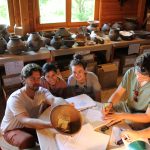Blog posted by Zachary Bible
Leaving this World in Style: A Study of Bronze Age Ceramic Urn Designs
How would you like to be remembered? Leaving a “mark” on the rest of the world does not only apply to others’ memories, but can also refer to physical objects associated with someone — long after they have “left this world.” For example, if you would prefer to be cremated rather than buried, and chose to be contained in an urn, is there a specific style that you would like the urn to express? Would it reflect favorite colors, shapes, and patterns? Perhaps decorations common to your heritage or background? Would it be possible for someone in the distant future to look at these design features and know where you originated from or what cultural group you were a part of?

During BAKOTA’s research and studies in the Great Hungarian Plain, the ceramic stylistic analysis team is attempting to do just that with prehistoric peoples — using the materials that they have left behind. Particularly, I am looking at the decorations on ceramic urns and vessels, measuring different aspects of the art, and comparing it to other data that has been collected by past researchers. Different archaeological cultures express a variety of different design “elements.” From pointed “lugs” to channeled “spirals,” these features can tell us about the interactions between artisans and information about prehistoric trade. The goal of this work is to understand where different ceramic design styles originate from, and who created said styles.
For starters, the methods employed to gather this information involves measuring different decorations in millimeters. For example, a “channel” is a straight line of various widths that is lower than the surrounding area. The channel can then be part of a larger feature, such as the spiral pattern mentioned above. Previous work compares different styles and patterns from different areas or regions, attempting to trace the prehistoric artists who created particular patterns.

The composition of the vessel, or what kind of clay is heated to create them, is another important factor in discovering where these ceramics originated from. Imagine an archaeologist of the future, after discovering you or a loved one’s urn, and sampling some clay from the nearby river banks. This would be an effort to discover if your urn was created on site or, alternatively, imported from somewhere else. Between differences in design structures, plus the chemical composition of the ceramics, the BAKOTA project can use ceramic analysis for a fuller understanding and more accurate interpretation of the actions and movements of Bronze Age societies.
Other blogs on ceramic archaeology: * https://sha.org/blog/2018/02/ceramics-identification-clear-mud/ * https://www.rom.on.ca/en/blog/wyandot-approaches-to-archaeological-ceramics
